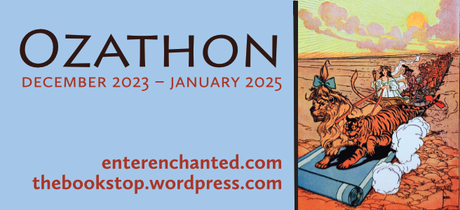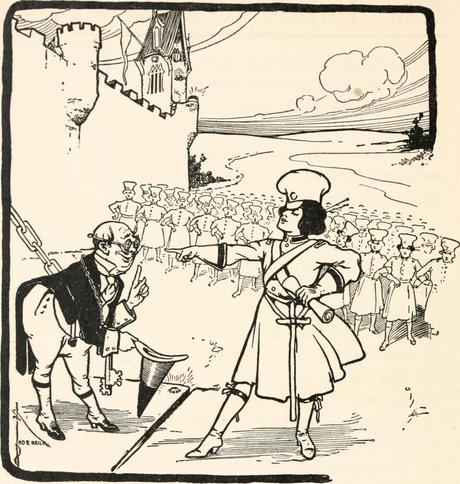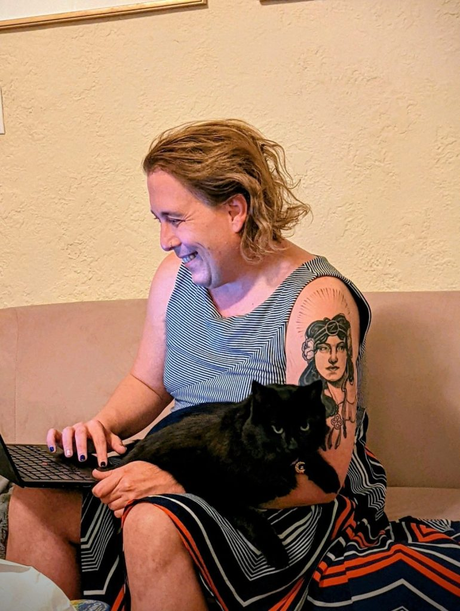I loved re-reading The Marvelous Land of Oz for Ozathon 2024. In a previous post, I shared some of the history and major themes of the book. In this post I’ll go into a little more detail and discuss one of the key elements of the book – its ending. I normally wouldn’t try to avoid spoilers for a book that’s over 100 years old (120 in fact), but I hoped some might pick up this book for the first time, and I didn’t want to spoil the wonder of the ending.

You can find other Land of Oz posts here:
Baum excels in writing for both children and adults, and I found I enjoyed Land of Oz much more as an adult. As a child I was a little dismayed that Dorothy wasn’t in it, and I couldn’t appreciate a lot of the wordplay and political themes in the book. I saw the book as “transitional” — a bridge between The Wizard of Oz and the rest of the series.
There were many memorable moments in this book. I love when Jack Pumpkinhead first calls Tip his father, the translation scene between Jack and the Scarecrow, when Mombi turns herself into a flower and is plucked by the Tin Woodsman, and when Glinda hops on the back of the Sawhorse, saying “Now you shall prove that you have a right to be alive! Run — run — run!”
Purpose, parenthood, and the meaning of life
Indeed, the right to be alive is a common theme in this book, and in other Oz books. Jack Pumpkinhead, the Sawhorse, and the Gump are given no choice in the matter. They were created and brought to life to serve a purpose, but with no thought to their well-being. As sentient beings, what does it mean to be alive, and who do they serve? And more importantly, who is responsible for their care? (We will see this theme explored more in another of my favorites, The Patchwork Girl of Oz.)
Tip, who has grown up without a family, takes on a parental role for the immature Jack Pumpkinhead. Throughout the book he teaches him, protects him from the insults of the Woggle Bug, and tries to improve Jack’s limbs when he realizes how fragile his creation is. For me, it’s these moments that speak most about his character.
Similarly, the Gump is brought to life to help Tip and friends escape the Emerald City. The Gump is created from two sofas tied together, two giant palm fronds for wings, a stick for a tail, and a taxidermied animal head (resembling an Elk with a goat’s beard). He’s immediately embarrassed to be composed of an assortment of junk. He accepts his purpose but when that’s over, he begs to be dismantled. The head still lives on a wall of the Emerald City palace and talks to people when it wants to.

“I did not wish to be brought to life, and I am greatly ashamed of my conglomerate personality. Once I was a monarch of the forest, as my antlers fully prove; but now, in my present upholstered condition of servitude, I am compelled to fly through the air – my legs being of no use to me whatever. Therefore I beg to be dispersed.”
Oz is full of unusual beings, and Baum emphasizes the importance of tolerance of others’ differences. His characters frequently feel “different”, which I found comforting as a child, as Baum emphasizes that “the only people worthy of consideration in this world are the unusual ones.” While it could be read as saying some people are better than others, in the context of the discussion the Scarecrow is saying that every unusual member of their party has something to offer. I think one reason I love Oz so much is the idea that everyone is accepted there.
Gender equality
Baum was a strong proponent of feminism, through his wife and her mother, and this is seen throughout the book. For the first half of the book, it seems like women are the villains in this story. The adventurers are all male and the conquerors, Jinjur, her army, and old Mombi, are all women. Then, the adventurers go to Glinda, who immediately takes charge in her gentle and wise way. It’s notable that while Jinjur’s army is eventually defeated and the women sent back to their homes, they are beaten only by a stronger female army.
Baum frequently plays on gender stereotypes; women who look beautiful or seem gentle may be exactly the opposite, and the males in his books are susceptible to being fooled by them. Ultimately, beauty and ugliness have little meaning in a world where people can be transformed to look like anything.
As I child I remember being bothered by some of Baum’s comments about Jinjur and her army, as Jinjur lounges around eating chocolates and her army removes jewels from the streets of the Emerald City. It felt like Baum was mocking the women’s cause. But as an adult I can see that while Baum levels fair criticisms at the women, he never says that women shouldn’t be in charge, and shows that a just system would take into account the needs of everyone without putting one gender above the other. And even though the women do go back to cooking and cleaning, they are more appreciated for the work they do.
Baum is frequently criticized for his inconsistency in explaining the history of Oz. In this book he makes the wizard the villain – it is the wizard who ousts Pastoria, the “rightful” ruler, conspires with Mombi to hide the heir, and later takes out every witch who threatens his rule (a very far cry from the “very good man” we meet in The Wizard of Oz and also very different from the wizard we encounter in the later books).

In this book, the right to rule isn’t about who is strongest or wisest, it’s a matter of lineage. This goes back to the theme of purpose – in general, Baum believes people should fulfill their purpose, and they don’t always get to choose. Whether you are born to be the ruler of Oz or a Sawhorse, you should carry out that purpose to the best of your ability.
Ozma and gender identity
At the end of the book, the travelers find out that the rightful heir to Oz is a girl who Mombi hid away by disguising her as a boy. It’s a thrilling moment in the book, and I imagine it must have been quite unexp;ected for readers. I’ve thought a lot about what the ending says about gender. Tip is essentially gender-neutral, both in name and personality; yet it’s completely understandable that he’s frightened to become a girl. His whole life is about to change – he doesn’t want to rule Oz, and he certainly doesn’t want to be female. As a girl I sympathized. Boys seem to have so much freedom compared to being a girl.
Tip tells Glinda he’ll try being a girl but if he doesn’t like it, she has to change him back. Glinda scoffs at that, since she’s not changing him, but returning him to his true form. And once transformed, she is beautiful and dainty and speaks sweetly. But what she says is “I hope none of you will care less for me than you did before. I’m just the same Tip, you know.” So how much of gender is nature and how much is societal expectation? There’s no question Tip will be treated differently, even if he/she are exactly the same person.

The transformation of Tip to Ozma took on new meaning to me through Amy Schneider, a Jeopardy champion and a trans woman who wears an Ozma tattoo on her arm. I admired Amy from her Jeopardy appearances before I knew anything about her tattoo. In one interview Amy explained:
Frank Baum wrote The Wizard of Oz, then went on to write a dozen or so sequels, and in all of them, Ozma is the ruler of Oz. Her backstory is that she was the rightful heir to the throne, was kidnapped as an infant by an evil sorceress, and then enchanted and raised as a boy until she was a teenager. Then, the enchantment was lifted and she was revealed to be the beautiful Princess Ozma that she had always been. So, when I transitioned—I loved those books as a kid—and so it just seemed like such an obvious thing to do.
Amy Schneider
I had never considered how Ozma would be an icon for the trans community, but I love that. While I think about Ozma in terms of gender equality (it makes no difference whether she is a boy or girl) the trans community may see it as we all have a “true” form.

